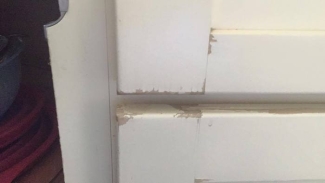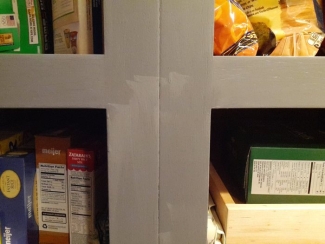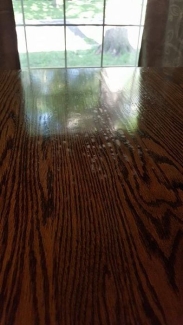

There are several reasons:
1. The cabinets were not prep cleaned and sanded properly. Sanding and cleaning are an essential part of any refinishing process.
In most cases, you can use a 220 sanding pad to scuff the surface and clean with a 50|50 mix of water and denatured alcohol.
If your current finish is chipping, it is failing to adhere correctly. The adhesion problem could be caused by several reasons:

If your current finish is chipping, it is failing to adhere correctly. The adhesion problem could be caused by several reasons:
Vinyl or paper veneers can be often found on the end returns of lower price-point cabinets. We cannot guarantee that our paints will adhere well to a paper veneer - we have no idea what the actual material is or what adhesives were used to apply the veneer to the surface. The resins and additives in our paints may break down the adhesives used for the veneer.
And Milk Paint does NOT adhere to vinyl.

Milk Paint is not like a filler-based wall paint. It is engineered for high-use applications such as tabletops and cabinets that require considerably more durability than a wall. The resins that make Milk Paint durable change the properties of it, so you have to handle it differently.
The type of applicator you use will change the thickness of the film and affect the appearance GF Milk Paint.
There is no easy solution to this problem. General Finishes Milk Paint has strong adhesion properties but there are several reasons this finish could fail:
Cassie of Primitive and Proper wanted to be bold and she took up the challenge by updating her living room fireplace with
General Finishes Milk Paint is a premium low VOC, self-sealing interior/exterior mineral-based paint named for its low-luster sheen. So durable, it is a go-to finish for cabinets and furniture.
Our recommendation to fix white cabinets that have yellowed is to do a thorough sanding and precleaning and recoat with the following products:

The problem areas on your table are probably caused by surface contamination from oils, waxes or cleaning products used over the years.
Contaminants from dusting sprays that contain silicone will also impact the appearance and adherence of a finish - silicone is almost impossible to remove. Oil soaps and wax can also cause adhesion failures. This may be why the finish is performing differently on the leaves vs the table top. Adhesion failure is often more obvious in the deepest patterns of grain because the contamination is driven deep into the grain.